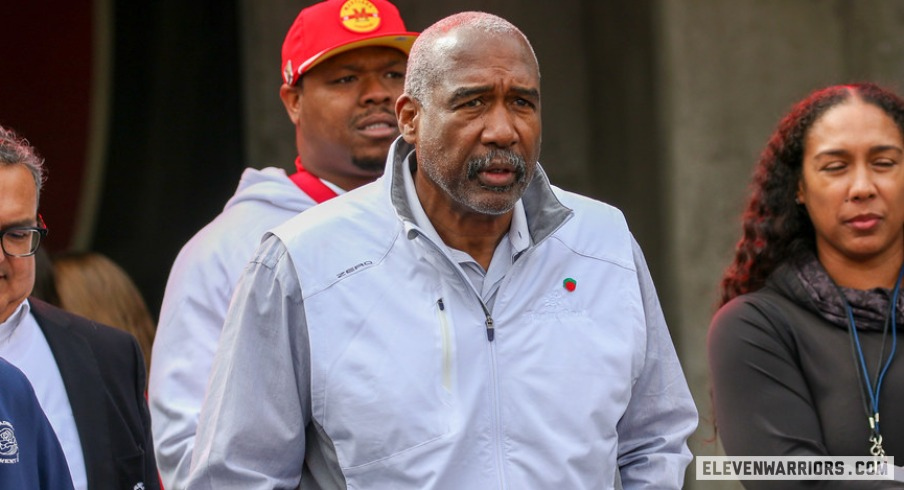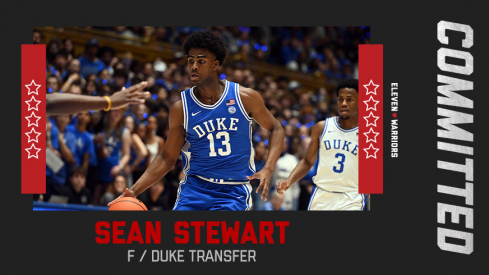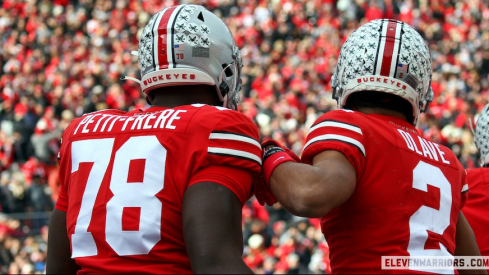Former Duke forward Sean Stewart, a five-star recruit in the 2023 class, commits to Ohio State.
It’s wild to think it’s been less than three years since college athletes could begin making money off of their name, image and likeness.
Players are now collecting thousands, hundreds of thousands or even millions of dollars from third-party NIL collectives. Despite the intentions of administrators to make it otherwise, that money is often being used as an inducement for recruits and transfers to attend universities around the country.
The genie is never going back in the bottle. Player pay is here to stay. But the unregulated nature of NIL as it stands doesn’t appear to be a permanent solution.
Many models have been tossed around college athletics circles, including profit-sharing plans and the potential for athletes to become employees and earn a salary.
On Thursday, outgoing Ohio State athletic director Gene Smith shared his own vision for the future, in which athletes’ “NIL rights” would include a cut of profits from TV deals and ticket sales, as well as endorsements and the like. And university athletic departments would oversee it all.
“There’s going to be some revenue share,” Smith said. “Obviously football is very much a part of that. I look at it this way, just simplifying it: It’s room, board, books, tuition, cost of attendance, Alston money (recently added awards for academic achievement), and I’m hopeful that it’s NIL rights, whatever that number is. And so hopefully that happens.”
Regardless of whatever model emerges, Smith wants to ensure that personal development remains at the core of collegiate athletics, as he’s strived to ensure it has during his 19-year career as Ohio State athletic director.
“We don’t draft, we recruit,” Smith said. “So our coaches sit in front of parents or a third-party person and convince that person that Ohio State is the right place for them to come and be developed. That core is still there. That’s our responsibility. Now the proposition changes a little bit with NIL, changes with what’s gonna happen in the future around the House case in particular where we’re going to have a different compensation model, probably, for student-athletes.”
The “House” case Smith refers to is not some legislation before the U.S. House of Representatives, but rather the House v. NCAA court case being heard in the Northern District of California. It’s a class-action antitrust lawsuit filed by former Arizona State swimmer Grant House, one that seeks damages for all student-athletes who weren’t allowed to make NIL dollars during their careers for as far back as the statute of limitations will allow.
An estimated 14,000 current and former athletes could be eligible to claim part of a multi-billion dollar payout if the NCAA loses the case.
The larger implication of those litigations going forward is that the suit is targeting the media rights deals that the NCAA and conferences have signed over the years like the Big Ten’s seven-year, $8 billion TV deal inked last year. If House and the other plaintiffs win the case, a portion of those media deals might be required to be given to student-athletes going forward.
That’s just one of a collection of antitrust lawsuits the NCAA is facing that are challenging player pay models. An important one signed into law mere days ago in Virginia made it illegal for the NCAA to punish any school within the commonwealth for compensating athletes for NIL rights. That will allow Virginia-based programs to bring their NIL in-house and should pave the road for schools in other states to do the same.
In the same vein, the NCAA ratified a policy on Monday that allows schools to identify and facilitate NIL deals for their student-athletes with third parties.
Such legislation aligns with the vision Smith has.
“You’ve got 125 football players, you’ve got 13 basketball players, you’re at 138 (athletes to compensate),” Smith said. “For us, at least, you’ve gotta find 138 women on the other side. So you’ve got 276 student-athletes, you’ve gotta figure out what that model is. What is that other number, I call it NIL rights. Then you create a licensing program for all of your student-athletes, you bring NIL in-house like Virginia is doing, then you allow the university and you allow the athletic department to be able to do NIL deals for those student-athletes.”
“There’s going to be some revenue share.”– Gene Smith
Smith said one of the advantages of such a model is that it could be tailored to each student-athlete with NIL deals that fit their interests or personality.
Whatever the path forward is, Smith doesn’t expect the NCAA to be the ones to do what needs to be done.
“We need Congress’ help,” Smith said. “I’m not so sure what the outcome of the antitrust cases will be, but we need Congress’ help. I’m not a believer that student-athletes should be or will be employees. State laws across the country are so different, I think it’s gonna be very difficult for the NCAA or any organization to say, ‘OK, student-athletes are employees.’ What states are right-to-work states? The ethics laws are different in every state relative to employees.
“So the only way that happens is if Congress says, ‘OK, student-athletes are employees and this is the classification, the federal law around student-athletes across the country and how they’re gonna be dealt with as employees.’ There’s only one way to do that: Federal law. I’m not subscribing to Congress saying that student-athletes should be employees, but I do believe that, based upon what happens with some of these antitrust cases, we may need Congress to help us with some protections against some other lawsuits that could emerge over time. I don’t have a lot of faith in the NCAA structure getting us out of this.”
A consequence of a revenue share will be that it’s tougher to fund a vast array of varsity sports, even at a university that earns as much revenue from athletics as Ohio State does. Smith held a reputation for wholeheartedly supporting every program he could as athletic director, but he acknowledged that it would no longer be realistic for Ohio State to allocate as many resources as it currently does to all 36 sports if it begins sharing revenue with athletes.
“In the past, we’ve always had the expectation for all of (the programs) is to chase championships,” Smith said. “Realistically, you’re not providing all those resources that we currently provide because we have to reduce the budgets in order to fund whatever comes at the top level. Then you’ve just gotta change your expectations. My guess is we’ll still sponsor 36 sports, but X number will be sponsored at a different level of support.”
NIL and player pay have fundamentally changed the relationship between athletic departments and athletes. But to Smith, the development of a teenager into a young adult ready for life beyond sports is still critical.
“Agents are involved now in a lot of sports, so that proposition has changed as well, so how you deal with them there (has changed),” Smith said. “But hopefully you still have a chance to develop that 17-, 18-, 19-year-old around their values, their character, the issues that they’re dealing with.”
That’s the main reason he wants to keep college sports tied to education rather than creating a semipro model that licenses out school branding and doesn’t require players to attend school.
“I’d hate it,” Smith said. “I think whatever model exists has to be tethered to education. All the blessings that I’ve had, not just football players, athletes over the years, we’ve changed so many people’s lives. Many of them come into us and they’re very mature and they’re focused and they get things done and we’re facilitating their time and helping them develop. But there’s some that come to us at a very immature level. And we do a great job of getting them maturity.”


